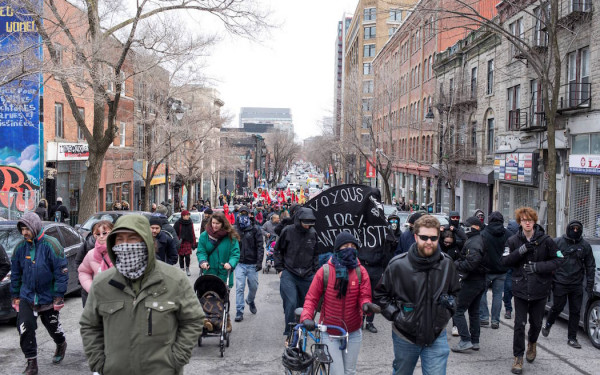Female Perspectives on Montreal Demonstrations
Taking to the Street as a Woman
The doctor estimated a six-month recovery period for Katie Nelson, a philosophy student at Concordia.
She suffers from tendon damage to one arm, a contusion to her right knee and a concussion.
According to Nelson, she sustained the injuries at a night demonstration against austerity on Dec. 18, when she was body checked by a police officer.
“There were about eight cops around me that night, and I was thrown across the street by one,” Nelson said. “I think that they have an advantage with how badly they hurt me because I’m a woman.”
She estimates that she has been to about a hundred marches since moving to Montreal from Alberta in 2012.
March 15 is the International Day Against Police Brutality. Those present at the annual march this year, organized by the Collective Opposed to Police Brutality, will be taking to the streets to demonstrate against police violence and social profiling.
In Montreal, police violence often occurs in conjunction with demonstrations. It’s an all too common narrative: those in power construct the use of public space according to their own ideologies and interests, and those who disrupt that dominant view, like protestors, are punished.
The use of police force to dismiss demonstrations in Montreal has been historically recorded for decades. It’s difficult to monitor that use of force, though, as it’s dismissed by authorities—like in Nelson’s case—or not reported at all.
Nelson filed a previous $24,000 lawsuit against the city in 2013. The police officer dressed in civilian clothes that attacked her in December is among the officers to be mentioned specifically in her lawsuit, according to her.
She said they recognized each other and believes she was targeted, but the police officer is “denying that they were involved,” and “doesn’t want to take responsibility.”
This lack of accountability is the reason why there are few official statistics available on the subject, other than testimonies to this violence. Nelson mentioned that when she was taken to the hospital in December, police had already identified her case and had asked the officers to deny any affiliation to her injuries.
“It’s a whole new level of police violence and hastiness of covering up what had happened,” Nelson said.
The Special Investigations Unit is a civilian agency in the province of Ontario that dedicates its work to investigating cases of police violence. Its model, which assures greater civilian accountability of police, is one-of-a-kind in Canada. It investigates reported severe injuries, deaths and sexual assault cases that involved police and civilians.
The Collectif les Sorcières, a radical feminist collective in Montreal, has made a similar attempt to document accounts of police violence against women. They recently published a collection of stories from women who suffered from police violence in a zine format.
“I saw repression [at the April 7 protest] but it was different,” said Isabelle, a member of the collective. April 7, 2015 was the date of a female-only demonstration that ended with a forceful police intervention in the use of tear gas, strikes and arrests. Isabelle spoke to The Link on the condition of anonymity fearing repercussions from police.
The idea to put together the zine stemmed from that demonstration.
“We’ve always had problems with police brutality and the way they express themselves towards women,” Isabelle said.
“We’ve always had problems with police brutality and the way they express themselves towards women.” —Isabelle, member Collectif les Sorcières.
That night, there were two arrests and several testimonies from women injured by police officers.
Repression and police brutality are two tactics commonly used by the police, said Isabelle. Women, especially, experience a different kind of violence that’s not often talked about or recognized. She mentioned sexist comments from police officers like “go back to your kitchen,” or “go take care of your kids.”
“It’s very patriarchal and condescending,” Isabelle said.
Nelson’s beliefs are in line with this.
“What I’ve come to learn in the years I’ve had experience with police officers is that there’s a lot of misogyny and gender imbalance in terms of what position you are in and what you’re communicating,” she said.
According to Isabelle, that communication is often repressed by those in positions of power. There’s a limited number of non-mixed demonstrations in Montreal, which she estimates at one or two per year. Having a non-mixed demonstration allows for women to take up a space in the public sphere that’s not often given to them.
“It’s a moment of empowerment for women to take to the streets,” Isabelle said.
When women are active in mixed groups, they are often delegated behind-the-scene roles, like doing administrative tasks or making food for the group, Isabelle noted.
“Part of the violence also comes from being invisible,” she said. “We’re not seen or recognized as much as men.”
Nelson hasn’t been to a demonstration since that night in December.
“It was a very traumatizing event,” she said. “You suffer a lot psychologically from that. A lot of experience I’ve had with police has been gendered. It’s been sexualized, sexist or misogynistic.”
To this day, Nelson finds it unsettling to walk past police officers—she is slowly recovering from the incident. She doesn’t know if she will attend the upcoming anti-police brutality march on Tuesday.
“There’s a level of violation I felt as a woman, a piece of my identity has been stripped away,” Nelson said.

1web_700_1050_90.jpg)
_600_832_s.png)

_600_375_90_s_c1.jpg)
01web_600_375_90_s_c1.jpg)
1_600_375_90_s_c1.jpg)
